|
|
 |
 |
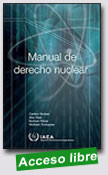 |
Manual de derecho nuclear
IAEA, 21 August 2006, 202 p.
This
publication is a new resource for assessing the adequacy
of national legal frameworks governing the peaceful uses
of nuclear energy. It provides practical guidance for
governments in enhancing their laws and regulations, in
harmonizing them with internationally recognized
standards, and in meeting their obligations under
relevant international instruments. This handbook
contains concise and authoritative information for
teachers (lawyers,
|
|
scientists,
engineers, health and radiation protection workers and
government administrators) on the basic elements of a
framework for managing and regulating nuclear
energy.
http://www-pub.iaea.org/MTCD/publications/PubDetails.asp?pubId=7445
|
 |
 |
Health
Risks from Exposure to Low Levels of Ionizing Radiation:
BEIR
VII Phase 2
National
Research Council , 2006,
424 p.
This
book is the seventh in a series of titles from the
National Research Council that addresses the effects of
exposure to low dose LET (Linear Energy Transfer)
ionizing radiation and human health. Updating
information previously presented in the
|
|
1990
publication, Health Effects of Exposure to Low Levels of
Ionizing Radiation: BEIR V, this book draws upon new
data in both epidemiologic and experimental research.
Ionizing radiation arises from both natural and man-made
sources and at very high doses can produce damaging
effects in human tissue that can be evident within days
after exposure. However, it is the low-dose exposures
that are the focus of this book. So-called late effects,
such as cancer, are produced many years after the
initial exposure. This book is among the first of its
kind to include detailed risk estimates for cancer
incidence in addition to cancer mortality. BEIR VII
offers a full review of the available biological,
biophysical, and epidemiological literature since the
last BEIR report on the subject and develops the most
up-to-date and comprehensive risk estimates for cancer
and other health effects from exposure to low-level
ionizing radiation. Amendment to the Convention on the
Physical Protection of Nuclear Material
extraído
de:
http://www.nap.edu/catalog/11340.html
http://www.nap.edu/catalog/11340.html
|
 |
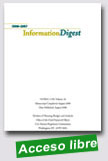 |
Information
Digest, 2006-2007 (NUREG-1350, Vol. 18)
US
Nuclear Regulatory Commission, August 2006, 148 p.
The
"U.S. Nuclear Regulatory Commission (NRC)
2006–2007 Information Digest" (the digest)
provides a summary of information about the U.S. Nuclear
Regulatory Commission (NRC), including the agency’s
regulatory responsibilities and licensed activities, and
general information on domestic and worldwide
|
|
nuclear
energy. Published annually, the digest is a compilation
of nuclear- and NRC-related data designed to serve as a
quick reference to major facts about the agency and the
industry it regulates. In general, the data cover up to
2005 or data available at manuscript completion.
Information on the generating capacity and average
capacity factor for operating U.S. commercial nuclear
power reactors is obtained from the NRC, as well as from
various industry sources. Industry source information is
reviewed by the NRC for consistency only, and no
independent validation and/or verification is performed.
extraído de:
http://www.nrc.gov/reading-rm/doc-collections/nuregs/staff/sr1350/#pubinfo
http://www.nrc.gov/reading-rm/doc-collections/nuregs/staff/sr1350/
|
 |
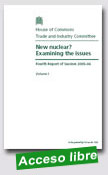 |
New
nuclear? Examining the issues
Fourth
Report of Session 2005–06. House of Commons. Trade and
Industry Committee. Volume I, Report, together with
formal minutes. July 2006, 92 p.
The Government’s decision on the future of the energy
sector, and with it the outlook for nuclear power in the
UK, is one of the most important issues it has faced in
its time in office. The outcome of the 2006 Energy
Review will have ramifications
|
|
not just for this generation, but for generations
to follow.1 This means it is vital that the Government
makes its current assessment on the basis of all the
available evidence, with a view to putting in place a
framework to safeguard the long-term sustainability of
the UK’s energy supply.
extraído
de:
http://www.parliament.uk/documents/upload/Nuclear%20New%20Build%20FINAL.pdf
|
 |
 |
Radiological
Protection Issues in Endovascular Use of Radiation
Sources
IAEA,
8 March 2006, 43 p.
Endovascular application of
suitable radiation sources is one of the treatment
modalities to prevent restenosis after percutaneous
coronary and peripheral interventions. The procedure is
highly interdisciplinary in nature, involving at least
one interventionist (e.g. cardiologist, angiologist,
radiologist or surgeon), a radiation oncologist and a
medical physicist. This publication meets the need to
disseminate i
|
|
nformation on a number of
incidents/events resulting in undue radiation exposure
of personnel and patients, with a view to reducing the
chances of similar recurrences, or in fact of preventing
them. The publication has been written in a
straightforward manner and is primarily directed at
physicians involved with the use of radioactive sources
for endovascular interventions. It will also be useful
for medical physicists, radiation oncologists and
hospital administrators in introducing to them the types
of event that can occur in such applications. It is not
meant to exhaustively review dosimetry techniques and
quality assurance.
extraído
de:
http://www-pub.iaea.org/MTCD/publications/PDF/te_1488_web.pdf
|
 |
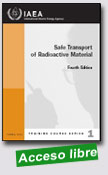 |
Safe
Transport of Radioactive Material (Fourth Edition)
IAEA,
Training Course Series No.
1, 2006, 454 p.
The
IAEA has been publishing Regulations for the Safe
Transport of Radioactive Material since 1961. Meeting
its statutory obligation to foster the exchange and
training of scientists and experts in the field of
peaceful uses of atomic energy, the IAEA has developed a
standardized approach to transport safety training. This
training manual is an
|
|
anchor
of the standardized approach to training. It is a
compendium of training modules for courses related to
the different aspects of safety of transport of
radioactive material. Keeping in view the specific needs
of the potential users, the manual includes material
that can be used for a variety of training programmes of
duration ranging from half-a-day to ten days, for
specific audiences such as competent authority
personnel, public authorities, emergency response
personnel and cargo handlers.
extraído de:
http://www-pub.iaea.org/MTCD/publications/PDF/TCS-01_4th_web.pdf
|
 |
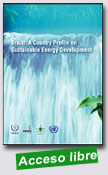 |
Brazil:
A Country Profile on Sustainable Energy Development
IAEA,
1 September 2006, 252 p.
This
publication is the product of an international effort to
develop a novel approach for the comprehensive
assessment of national energy systems within a
sustainable development context. The study represents
the first of a series of national studies being
conducted through a partnership initiative under the
World Summit on Sustainable Development and the United
Nations Commission on
|
|
Sustainable
Development. The study comprises a quantitative and
qualitative analysis of Brazil's energy needs, supply
and security; domestic resources; technology development
and innovation; and alternative future scenarios taking
into consideration sustainable development criteria and
goals defined by Brazilian experts. Social, economic and
environmental issues and trends are examined in detail
using statistical analysis of historical data,
integrated demand and supply modelling systems and
Energy Indicators for Sustainable Development. The
quantitative assessment is complemented by discussions
of major institutional and infrastructural
considerations. The report summarizes the analyses,
identifies major energy priority areas for Brazil and
explores policy options useful to decision makers and
specialists in energy and the environment.
Contents:
1. Introduction; 2. Status; 3. Domestic Energy
Resources; 4. Indigenous and Adapted Energy Technologies
and Energy Efficiency; 5. Energy and Economic
Development; 6. Energy, the Environment and Health; 7.
Energy and Social Issues; 8. Energy Security; 9. Policy
Options for Sustainable Energy Development; 10.
Scenarios; 11. Conclusions and Lessons Learned.
http://www-pub.iaea.org/MTCD/publications/PubDetails.asp?pubId=7490
|
 |
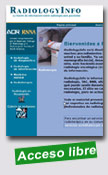 |
International
Nuclear Law in the Post-Chernobyl Period
OECD
Nuclear Energy Agency
and International Energy Agency, 2006, 241 p.
The accident which took
place on 26 April 1986 at the Chernobyl nuclear power
plant in Ukraine was to have a decisive influence on the
development of international nuclear law over the
following two decades. Within six months of the
accident, a
|
|
convention
on early notification of a nuclear accident and a
convention on assistance in the event of a nuclear
accident or radiological emergency were negotiated and
adopted under the auspices of the International Atomic
Energy Agency. In 1988, a joint protocol forming a
bridge between the two existing international nuclear
liability regimes was established. 1994 saw the adoption
of a convention establishing international benchmarks
for nuclear safety, followed by a convention on the
safety of spent fuel and radioactive waste management in
1997. The existing international regimes governing
liability for nuclear damage have been significantly
reinforced and a new global regime created. The purpose
of this compendium, jointly produced by the OECD Nuclear
Energy Agency and the International Atomic Energy
Agency, is to provide thoughtful analysis on each of the
above instruments, demonstrating the extent to which
progress has been made and identifying areas in which
further improvement would be desirable. It reproduces a
number of articles which have been published in the
OECD/NEA Nuclear Law Bulletin, accompanied by some
previously unpublished works. It also summarises the
practical steps taken by the respective international
organisations that support the international legal
framework.
extraído de:
http://www.nea.fr/html/law/chernobyl/Foreword.pdf
|
 |
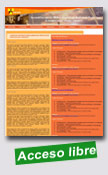 |
Second
European International Radiation Protection Association
IRPA Congress on Radiation Projections
Proceeding
of Full Papers, IRPA, 15-19 May 2006, Paris
The Second European
International Radiation Protection Association (IRPA)
Congress to be held in Paris, from May 15 th to May 19
th 2006, will be organised by the French Society for
Radiation Protection (SFRP).This European Congress, a
global forum on the Radiological Protection field, will
be a
|
|
unique opportunity to
present papers on and debate about all those subjects
which will determine the future of this speciality,
ranging from the scientific data and questions about
biological radiation effects, to the regulation and
practice of radiation protection.
This includes the control of
exposure to natural radiation, to professional and
medical radiations, the evolution of the radiological
protection system, the protection against non-ionising
radiations and the participation of the public with
respect to more sensitive questions. This
multidisciplinary approach,which covers a broad panel of
skills, gives us the opportunity to propose to you a
“Radiation Protection: from Knowledge to Action ”
tour.
extraído de:
http://www.irpa2006europe.com/
|
 |
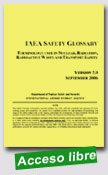 |
IAEA
Safety Glossary: Version 2.0
IAEA, September 2006, 193 p.
The
IAEA Safety Glossary defines and explains technical
terms used in IAEA safety standards and other safety
related IAEA publications, and provides information on
their usage. It has been in use as Version 1.0 since
April 2000. Version 2.0 was issued in September 2006.
The Safety
Glossary provides guidance primarily for the drafters
and reviewers of safety standards and |
|
other
publications, including IAEA technical officers and
consultants and members of technical committees,
advisory groups, working groups and bodies for the
endorsement of safety standards.
The primary purpose of the Safety Glossary is to
harmonize terminology and usage in the IAEA safety
standards and in their application and in the work of
the Department of Nuclear Safety and Security generally.
Users of the Safety Glossary, in particular drafters of
national legislation, should be aware that the terms
included have been chosen and the definitions and
explanations given have been drafted for this purpose.
Terminology and usage may differ in other contexts, such
as in the publications of other organizations and in
binding international legal instruments.
The Safety Glossary is also a source of information for
other Agency staff — notably writers, editors,
translators, revisers and interpreters — and for users
of IAEA safety standards and other safety related IAEA
publications.
extraído de:
http://www-ns.iaea.org/standards/safety-glossary.htm
|
|
|
|
|
